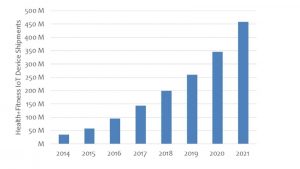
IoT wearable market is ‘healthy’
Stephen Law
Electronics Engineering IoT Wearable TechnologyHow Fitness and Medicine Wearables will revolutionize the future of medicine and the IoT
The change from ‘Fee for Service’ to ‘Value Based’ healthcare is driving the market toward monitoring devices with a wide range of capability and purpose, according to brand new research on health and fitness IoT devices from Mobile Experts.

The IoT wearable market is looking healthy: How fitness and medicine wearables will revolutionize the future of medicine and the IoT.
Source: Mobile Experts
In the first half of 2016, 45-million of these wearable devices were shipped, says the report, which offers a thorough look into the application of IoT devices in healthcare, zeroing in on wearables for fitness and medical use. Future applications for these wearables include smart pill bottles, ‘telemedicine’, remote diagnostics and remote surgery.
“The global healthcare market has started a slow, sweeping change in philosophy,” remarked principal analyst Joe Madden. “Multiple forces are now changing the business model, so that healthcare providers are compensated based on health, not based on transactions. Technology is a major enabler in this trend. We expect to see strong growth in fitness and medical wearable devices that are more integrated with clothing. We anticipate heavy adoption of smart pill bottles and other devices to precisely monitor the drugs taken by patients. Overall, information is required to make 21st century healthcare profitable.”
Analysis delves into telemedicine IoT devices
The research includes 30 charts and figures that break down details in the 41-page report. The analysis delves into telemedicine IoT devices. Blood pressure, ECG, EEG, temperature, glucose, and other measurements can be performed on the patient at various levels, with Bluetooth-enabled wearables in some cases and MICS/Medradio connectivity for others. All kinds of data will be uploaded to cloud applications for review by a doctor who may be located elsewhere.
“Wellness program incentives blur the line between fitness tracking and medical insurance,” says Madden. “There are interesting products out there such as ‘smart socks’ that can help an athlete to improve performance, or help an injured person to rehab.”
